
Stenocereus beneckei f. inermis Photo by: Valentino Vallicelli
Origin and Habitat: Central Mexico
Habitat: Grows on the sunniest parts of rocky cliffs.
Synonyms:
See all synonyms of Stenocereus beneckei
Description: Stenocereus beneckeiSN|8265]]SN|25145]] is a shrubby, semi-prostrate columnar cactus with tuberculate ribs. It forms untidy, much branched bushes 1-2(-5) meters high. This plant has an attractive grey white bloom on the new growth. The "Stenocereus beneckei forma inermis" is a cultivated strain easily distinguishable from the standard species for the almost spineless and very white stems. For all other characteristics it is comparable to the standard from.
Stem: Erect or decumbent, bluish-green or bronze-green up 1-2 (or more) m long, 4-7 cm in diameter, the growing tips very glaucous with a powdery silvery-white waxy coating.
Ribs: 5 to 9 strongly tuberculate, obtuse, separated by narrow intervals.
Areoles: Small, circular, borne on the upper side of the tubercle, reddish-brown to black-felted 2- 5 cm apart.
Spines: Absent or 1 to 3 very reduced, brown or black at first.
Flowers: Night-blooming, narrowly funnel-shaped, cream or greenish brown coloured , 4 cm long or more; inner perianth-segments rose-coloured to greenish-white; ovary globose, glaucous, tuberculate, with small felted areoles bearing 3 to 7 acicular spines or none.
Blooming season: Winter, opening during the night and staying open 24 hours.
Fruit: Less than 5 cm long, 2-3 cm wide, greyish-brown or reddish-brown, tuberculate bearing 8-9 spines per areole, up to 2 cm long; pericarp thick, somewhat fleshy; pulp disappearing, leaving the large seeds loose, these escaping by a basal pore as in Oreocereus and many of the Echinocactanae.
Seed: Large (approx. 3,5 mm) shiny black.
Note: The presence of a horizontal notch midway between areoles is a distinctive feature in Stenocereus beneckei, Stenocereus martinezii, Stenocereus quevedonis, and Stenocereus thurberiSN|25145]]SN|8265]], but is absent in the remaining species of Stenocereus and other genera.
Subspecies, varieties, forms and cultivars of plants belonging to the Stenocereus beneckei group
Bibliography: Major refeences and further lectures
1) Theodore H. Fleming, Alfonso Valiente Banuet “Columnar Cacti and Their Mutualists: Evolution, Ecology, and Conservation” University of Arizona Press, 2002
2) Britton & Rose "The Cactaceae" 4: 273, 1923
3) David Hunt, Nigel Taylor “The New Cactus Lexicon” DH Books, 2006 ISBN 0953813444, 9780953813445
4) Edward F. Anderson “The Cactus Family” Timber Press, 2001
5) James Cullen, Sabina G. Knees, H. Suzanne Cubey “The European Garden Flora Flowering Plants: A Manual for the Identification of Plants Cultivated in Europe, Both Out-of-Doors and Under Glass”Cambridge University Press, 11/ago/2011
6) David Hunt, Nigel Taylor “The New Cactus Lexicon” DH Books, 2006 ISBN 0953813444, 9780953813445
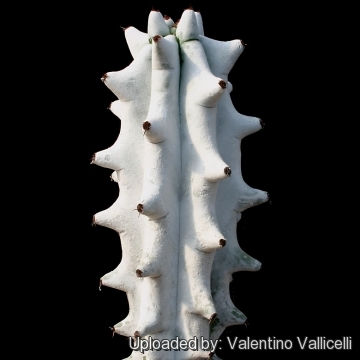 - (a very white clone ex Prof. Lodi collection - Bologna Botanical Garden) This species has an eye catching white/silver powdery bloom on the new growth.
But the bloom rubs or washes off easily so the lower parts of the stems
are usually a blue green or even bronze colour in strong light. Photo by: Valentino Vallicelli
- (a very white clone ex Prof. Lodi collection - Bologna Botanical Garden) This species has an eye catching white/silver powdery bloom on the new growth.
But the bloom rubs or washes off easily so the lower parts of the stems
are usually a blue green or even bronze colour in strong light. Photo by: Valentino Vallicelli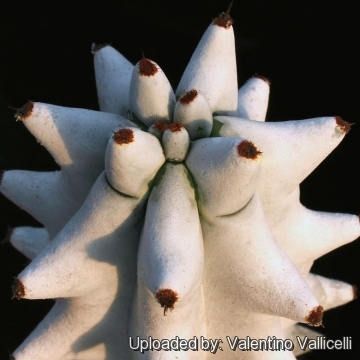 Stenocereus beneckei f. inermis Photo by: Valentino Vallicelli
Stenocereus beneckei f. inermis Photo by: Valentino Vallicelli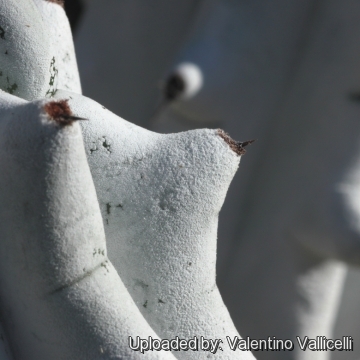 Stenocereus beneckei f. inermis Photo by: Valentino Vallicelli
Stenocereus beneckei f. inermis Photo by: Valentino Vallicelli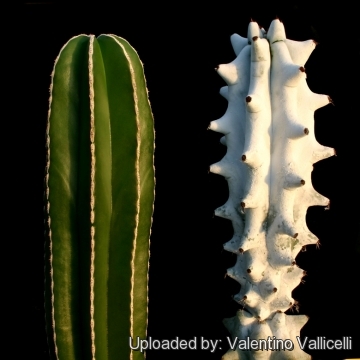 ...along with Stenocereus marginatus Photo by: Valentino Vallicelli
...along with Stenocereus marginatus Photo by: Valentino Vallicelli Stenocereus beneckei f. inermis Photo by: Valentino Vallicelli
Stenocereus beneckei f. inermis Photo by: Valentino Vallicelli Stenocereus beneckei f. inermis Photo by: Valentino Vallicelli
Stenocereus beneckei f. inermis Photo by: Valentino Vallicelli Stenocereus beneckei f. inermis Photo by: Valentino Vallicelli
Stenocereus beneckei f. inermis Photo by: Valentino Vallicelli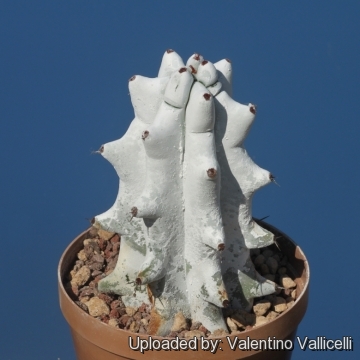 Stenocereus beneckei f. inermis Photo by: Valentino Vallicelli
Stenocereus beneckei f. inermis Photo by: Valentino VallicelliCultivation and Propagation: Stenocereus beneckeiSN|25145]]SN|25145]] is easy to grow but not very cold hardy (Resistant as low as -4°C for a short time).
Growth rate: It produces good amounts of growth each year if kept well fed and watered throughout the warmest months, particularly if it has been acclimatised to accept full sun. It will make clumps given the best conditions.
Soils: It likes very porous fertile cactus mix soil.
Repotting: Use pot with good drainage.
Watering: Water regularly in summer, but do not overwater (Rot prone), keep dry in winter.
Fertilization: Feed with a high potassium fertilizer in summer.
Hardiness: Reputedly sensitive to frost , but less so if kept on the dry side prior to, and during, cold weather (hardy to -4° C for short periods). However warmth throughout the year will increase the grower's success (8-12°C during rest season). During winter month, put them in a cool luminous place and encourage them to enter winter dormancy by withholding water and fertiliser over the winter as they will etiolate, or become thin, due to lower levels of light.
Exposition: Outside full sun, inside need bright light, and some direct sun. Tends to produce a dense white bloom in strong light, which encourages also flowering and spine production.
Uses: It is an excellent plant for container growing. It always looks good and stays small. It look fine in a cold greenhouse and frame or outdoor in a rockery.
Pests & diseases: It may be attractive to a variety of insects, but plants in good condition should be nearly pest-free, particularly if they are grown in a mineral potting-mix, with good exposure and ventilation. Nonetheless, there are several pests to watch for:
- Red spiders: Red spiders may be effectively rubbed up by watering the plants from above.
- Mealy bugs: Mealy bugs occasionally develop aerial into the new growth among the wool with disfiguring results, but the worst types develop underground on the roots and are invisible except by their effects.
- Scales: Scales are rarely a problem.
- Rot: They are susceptible to fungal diseases if overwatered, but are not nearly as sensitive as many other cacti, especially in warm weather. If kept damp through cold periods, they will invariably suffer. However rot is only a minor problem with cacti if the plants are watered and “aired” correctly. If they are not, fungicides won't help all that much.
Propagation: Division, direct sow after last frost. The seeds are quite easy to germinate and grow. Seeds germinate in 7-14 days at 21-27° C in spring, remove the glass cover gradually as the plants develops and keep ventilated, no full sun for young plants! To make a cutting twist off a branch and permit it to dry out a couple of weeks, lay it on the soil and insert the stem end partially into the soil. Try to keep the cutting somewhat upright so that the roots are able to grow downward.



















